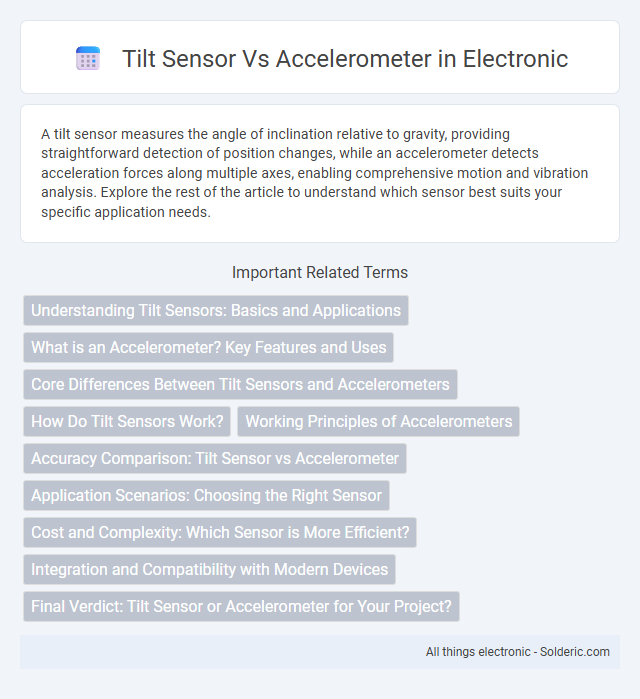A tilt sensor measures the angle of inclination relative to gravity, providing straightforward detection of position changes, while an accelerometer detects acceleration forces along multiple axes, enabling comprehensive motion and vibration analysis. Explore the rest of the article to understand which sensor best suits your specific application needs.
Comparison Table
| Feature | Tilt Sensor | Accelerometer |
|---|---|---|
| Function | Measures angle relative to gravity | Measures acceleration forces, including tilt and vibration |
| Output | Angle or tilt position | Acceleration in multiple axes (X, Y, Z) |
| Axes | Typically 1-axis or 2-axis | 3-axis (commonly) |
| Applications | Level detection, screen orientation | Motion sensing, vibration monitoring, gesture detection |
| Complexity | Simple, low-cost | More complex, higher cost |
| Power Consumption | Low | Moderate to high |
| Sensitivity | Detects steady tilt | Detects dynamic acceleration and tilt |
| Data Output Type | Analog or digital angle signal | Digital acceleration data |
Understanding Tilt Sensors: Basics and Applications
Tilt sensors measure the inclination or angle relative to gravity, making them ideal for detecting static positions in devices like smartphones, gaming controllers, and industrial equipment. In contrast, accelerometers capture acceleration forces, including dynamic movement and vibration, providing more detailed motion data. Understanding your application's requirements ensures choosing between tilt sensors for simple angle detection or accelerometers for comprehensive motion analysis.
What is an Accelerometer? Key Features and Uses
An accelerometer is a sensor that measures acceleration forces, detecting changes in velocity and orientation by capturing linear motion along multiple axes. Key features include high sensitivity, multi-axis measurement (typically 3-axis), and the ability to detect both static (gravity) and dynamic (movement) acceleration. Accelerometers are widely used in smartphones for screen rotation, in automotive systems for crash detection, and in wearable devices for activity tracking and gesture recognition.
Core Differences Between Tilt Sensors and Accelerometers
Tilt sensors measure angular displacement relative to the gravitational vector, detecting static orientation changes, while accelerometers capture dynamic acceleration forces along multiple axes, including motion and vibration. Tilt sensors are typically used for position monitoring in applications like level detection, whereas accelerometers provide detailed motion data for activity tracking, shock measurement, and inertial navigation. Your choice between the two depends on whether you need precise angle measurement or comprehensive acceleration and movement analysis.
How Do Tilt Sensors Work?
Tilt sensors detect the angle of an object's inclination relative to gravity by measuring changes in position or orientation. They typically use liquid electrolytes, conductive balls, or MEMS (Micro-Electro-Mechanical Systems) components to sense tilt and convert it into an electrical signal. Your choice between a tilt sensor and an accelerometer depends on the required accuracy and the type of motion or position measurement needed.
Working Principles of Accelerometers
Accelerometers operate by measuring changes in capacitance, piezoelectricity, or voltage as a result of acceleration forces acting on a proof mass within the sensor. These forces cause displacement or deformation of internal elements, which is then converted into an electrical signal proportional to acceleration across one or more axes. This principle enables accelerometers to detect dynamic movements, vibrations, and static tilt relative to gravity with high precision.
Accuracy Comparison: Tilt Sensor vs Accelerometer
Tilt sensors provide precise angle measurements relative to gravity, making them highly accurate for detecting static tilt positions but less effective in dynamic conditions. Accelerometers measure acceleration forces in multiple axes, delivering accurate motion and vibration data, but their angle estimation can be affected by linear movement and noise. For your application, choose a tilt sensor for stable orientation accuracy and an accelerometer for detailed dynamic motion analysis.
Application Scenarios: Choosing the Right Sensor
Tilt sensors are ideal for detecting static angles and orientation changes in applications such as screen rotation, level detection, and simple motion sensing. Accelerometers provide detailed dynamic motion data, making them suitable for vibration analysis, gesture recognition, and complex movement tracking in devices like smartphones and fitness trackers. Your choice depends on whether you need basic angle measurement or comprehensive movement detection.
Cost and Complexity: Which Sensor is More Efficient?
Tilt sensors generally offer lower cost and simpler design compared to accelerometers, making them ideal for basic angle detection applications. Accelerometers provide more comprehensive motion and orientation data but at higher cost and increased complexity due to multi-axis measurement capabilities and signal processing requirements. Choosing between them depends on the efficiency needed for specific applications, balancing budget constraints with performance demands.
Integration and Compatibility with Modern Devices
Tilt sensors offer straightforward integration in simple orientation detection systems due to their minimal interfaces and low power consumption. Accelerometers provide advanced motion analysis and multi-axis data, requiring more complex signal processing but offering compatibility with a wide range of modern devices such as smartphones, wearables, and IoT sensors. The choice depends on application complexity, with accelerometers favored for comprehensive motion tracking and tilt sensors suited for basic tilt detection with easy hardware compatibility.
Final Verdict: Tilt Sensor or Accelerometer for Your Project?
Choosing between a tilt sensor and an accelerometer depends on the specific requirements of your project, such as the need for precise angle measurement or dynamic motion detection. Tilt sensors offer reliable static angle detection with simplicity and lower power consumption, while accelerometers provide detailed multi-axis motion data suitable for complex movement and orientation analysis. Your project demands careful evaluation of these factors to select the optimal sensor for accurate and efficient performance.
tilt sensor vs accelerometer Infographic

 solderic.com
solderic.com